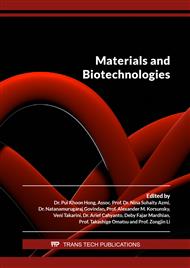p.79
p.87
p.95
p.103
p.111
p.121
p.129
p.135
p.145
Hardness and Compressive Strength Evaluation of Dental Composites Containing Biosilica-Encapsulated Healing Liquid
Abstract:
Tooth cavity is one of the most common dental health problems in Indonesia that can be treated by applying dental fillings. However, dental fillings often experience microcrack and secondary caries. Self-Healing Dental Materials (SHDM) which use microencapsulation technique as healing system, are developed to solve this problem. In this work, we employed mesoporous biosilica from Cyclotella striata TBI as microcapsule to entrap healing liquid contains polyacrylic acid and polybasic carboxylic acid. SHDM was prepared by mixing Filtek Z350XT flowable composite with fluoroaluminosilicate healing powder and healing liquid encapsulated in biosilica. We also added silica containing cetyltrimethyl ammonium bromide (CTAB@PSN) filler as antibacterial agent. Six groups of tested samples were prepared with various composition of biosilica and CTAB@PSN. Filtek composite was used as a control. We studied the entrapment of helaing liquid in biosilica and effect of biosilica addition towards mechanical properties of the resulting SHDM. The statistical analysis was determined using ANOVA. Scanning Electron Microscopy and Fourier Transform Infra-Red showed that the microencapsulation of healing liquid in biosilica was successful with immersion method without stirring. Addition of biosilica and CTAB@PSN fillers into the Filtek composites resulted in the decrease of the mechanical properties. The hardness values of the resulting composites were in the range 44.33–53.25 VHN. Nevertheless, the hardness values were still comparable to the hardness of dentin. Addition of filler decreased the compressive strength, but statistically insignificant, from 268.68 MPa to 228.53–252.04 MPa. To conclude, healing liquid can be entrapped in porous biosilica. Adding healing agent affects SHDM composite’s hardness but not its compressive strength.
Info:
Periodical:
Pages:
111-119
Citation:
Online since:
August 2022
Price:
Сopyright:
© 2022 Trans Tech Publications Ltd. All Rights Reserved
Share:
Citation:



